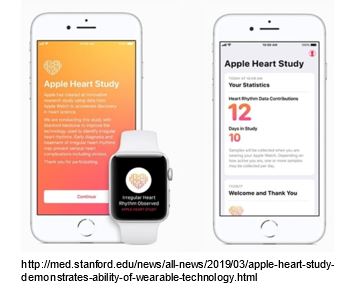Last November at AHA18, I was lucky enough to catch a talk from one of the investigators, Dr. Marco Perez, working on the Apple Heart Study, where he described the goals of the project. I even wrote about it for the blog I wrote at AHA18 in Chicago, which you can find here.
To quickly recap, this unprecedented collaboration between Apple and Stanford is a progressive clinical trial that uses data from Apple Watch devices from over 400,000 participants. The main purpose of this study was to examine if atrial fibrillation (AFib) can be reliably diagnosed from irregular pulse notification data from wearable devices. In November, Dr. Perez mentioned that they wouldn’t have data until early 2019, and this past March, they released some results that are really exciting.
Highlights from the findings include:
- Around 0.5% of participants received irregular pulse notifications, which was particularly important since people were concerned that these devices would potentially over-notify people.
- The pulse detection algorithm of the Apple Watch has a 71% positive predictive value – this was compared to simultaneous electrocardiography patch recordings.
- The majority of the time (84%) when participants received irregular pulse notifications, they were found to be in AFib at the time of the notification.
- 1/3 of the participants who received irregular pulse notifications and were then followed up by using an ECG patch over a week later were found to have AFib. This isn’t entirely surprising since AFib is an intermittent condition, so it’s not uncommon for it to go undetected in subsequent monitoring.
- 57% of people who received irregular pulse notifications sought medical attention afterwards.
- A clinical trial could be conducted in this large-scale virtual manner
The last point is particularly important because this is the first study of its kind. It was almost completely virtual, at least from the standpoint that the researchers analyzing the data never once had any contact with the participants. Additionally, the scope of the number of people who were analyzed is impressive – 400,000 participants is quite the sample size, especially for someone like me who studies heart disease in mice!
Because AFib is an extremely common condition, affecting between 2-6 million people in the United States, that often goes undiagnosed, understanding that wearable technology can aid patients in detecting their condition is huge. Also, with the increase in technology in our health care sphere (specifically in cardiology), something that was expertly discussed by Dr. John Chen earlier this year on his blog is that this is just the beginning in understanding how wearable technology can help us treat disease. We now have another tool in our kit, and this one looks promising.
In Stanford’s press release, Dr. Perez said, “The performance and accuracy we observed in this study provides important information as we seek to understand the potential impact of wearable technology on the health system. Further research will help people make more informed health decisions.”
Interestingly, Johnson & Johnson and Apple recently announced their plans to build off these preliminary results by partnering together in a new project called HEARTLINE. This study will focus on an older population (~ 65 years) of around 150,000 participants who, due to their age, are at a higher risk of AFib. It’s a really exciting time to be in the cardiology field since this is just the beginning of this type of research, which is full of therapeutic potential.
It’s also really thrilling to be able to follow-up with this study, especially since it all started with my father-in-law, who has AFib, being nervous about using wearable technology to detect his condition. I’m excited to share this data with him as well since maybe he’ll feel a little more comfortable using it now.
